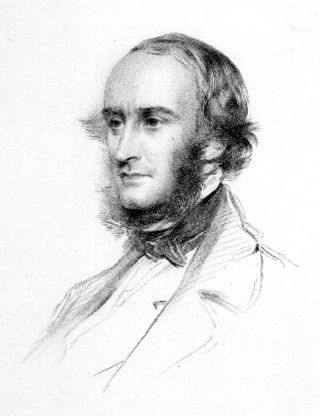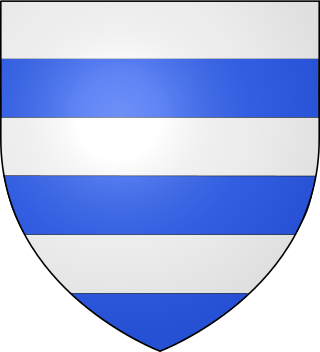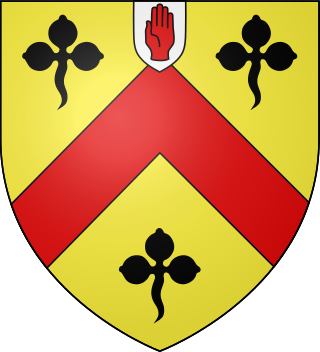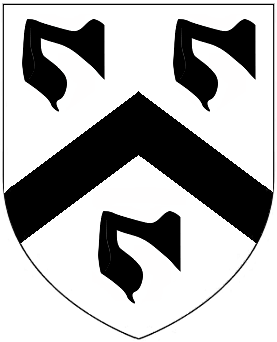Related Research Articles

Earl of Derby is a title in the Peerage of England. The title was first adopted by Robert de Ferrers, 1st Earl of Derby, under a creation of 1139. It continued with the Ferrers family until the 6th Earl forfeited his property toward the end of the reign of Henry III and died in 1279. Most of the Ferrers property and the Derby title were then held by the family of Henry III. The title merged in the Crown upon Henry IV's accession to the throne in 1399.

Earl of Sussex is a title that has been created several times in the Peerages of England, Great Britain, and the United Kingdom. The early Earls of Arundel were often also called Earls of Sussex.
There have been three baronetcies created for members of the Clerke family. One creation is extant as of 2008.

Baron Colebrooke, of Stebunheath in the County of Middlesex, was a title in the Peerage of the United Kingdom. It was created in 1906 for Sir Edward Colebrooke, 5th Baronet. He held several positions at the British court. The Colebrooke family descended from the London banker James Colebrooke. His second son James Colebrooke represented Gatton in the House of Commons. On 12 October 1759 he was created a baronet, of Gatton in the County of Surrey, in the Baronetage of Great Britain, with remainder to his younger brother George. He was succeeded according to the special remainder by his younger brother George, the second Baronet. He was Member of Parliament for Arundel and also served as Chairman of the Honourable East India Company.

The Alleyn Baronetcy, of Hatfield in the County of Essex, was a title in the Baronetage of England. It was created on 24 June 1629 for Edward Alleyn. The title became extinct on the death of the eighth Baronet in 1759.
There have been two baronetcies created for people with the surname Heathcote, both in the Baronetage of Great Britain and both created in 1733. The holders of the first creation were later elevated to the peerage as Baron Aveland and Earl of Ancaster, which titles are now extinct. However, both baronetcies are extant as of 2008.
There have been two baronetcies created for members of the Blackett family, both in the Baronetage of England. One creation is extant as of 2013. The Blackett family can be traced back to the Blacketts/Blakheveds of Woodcroft, County Durham, some of whom became highly successful in the lead and coal mining industries in Northumberland and County Durham.

The Bradstreet Baronetcy, of Castilla in County Dublin was created in the Baronetage of Ireland on 14 July 1759 for Simon Bradstreet. His son, the second Baronet died without male issue in 1773 and was succeeded by his younger brother, a Member of Parliament for Dublin in the Irish House of Commons, and later a judge. The fourth baronet was a barrister. The latter's elder son, the fifth Baronet died childless in 1889 and the title went to his younger brother. With the death of the seventh Baronet in 1924, the baronetcy became extinct.

The Hulse Baronetcy, of Lincoln's Inn Fields in the County of Middlesex, is a title in the Baronetage of Great Britain. It was created on 7 February 1739 for Edward Hulse, Physician in Ordinary to Queen Anne, George I and George II. The third baronet was High Sheriff of Hampshire in 1802. The sixth Baronet represented Salisbury in the House of Commons. The tenth Baronet was High Sheriff of Hampshire in 1978 and Deputy Lieutenant of the county in 1989. The Hulse family has common origin with the Holles Earls of Clare.

There have been two baronetcies created for persons with the surname Yelverton, both in the Baronetage of England.

There have been five baronetcies created for persons with the surname Kennedy, one in the Baronetage of Ireland, three in the Baronetage of Nova Scotia and one in the Baronetage of the United Kingdom. One creation is extant as of 2010.

The Newcomen Baronetcy, of Kenagh in the County of Longford, was a title in the Baronetage of Ireland. It was created on 30 December 1623 for Robert Newcomen. Born in London, the third son of Charles Newcomen and Jane Nightingale, Robert had come to Ireland in the late sixteenth century. He settled at Keenagh in County Longford, where he became a substantial landowner, and sat in the Irish House of Commons for Kilbeggan. By his first wife Katherine Molyneux, daughter of Sir Thomas Molyneux, Chancellor of the Exchequer of Ireland and Catherine Stabeort, he had twenty-one children, including the second, third and fourth Baronets. The fifth baronet was a Jacobite soldier. The sixth, seventh and eighth Baronets also represented County Longford in the Irish House of Commons. The eighth Baronet also represented Longford Borough in Parliament. The title became extinct on his death on 27 April 1789.

The Wilson, later Maryon-Wilson Baronetcy, of East Borne in the County of Sussex, was a title in the Baronetage of England. It was created on 4 March 1661 for William Wilson, of East Borne Place in the parish of Eastbourne, Sussex, a descendant of Sir Thomas Wilson (1524-1581), Knight, Secretary of State to Queen Elizabeth I. The sixth Baronet sat as Member of Parliament for Sussex. The eleventh Baronet assumed the additional surname of Maryon in 1899. The title became extinct on the death of the thirteenth Baronet in 1978.

The Fludyer Baronetcy, of The City of London, was a title in the Baronetage of Great Britain. It was created on 14 November 1759 for the merchant, banker and politician Sir Samuel Fludyer, with remainder in default of male issue of his own to his brother Thomas Fludyer and his issue male. The second Baronet was Member of Parliament for Aldborough. The title became extinct on the death of the fifth Baronet in 1922.
The Lucy Baronetcy, of Broxbourn in the County of Hertford, was a title in the Baronetage of England. It was created on 11 March 1618 for Richard Lucy, later member of parliament for Old Sarum and Hertfordshire. The second Baronet, Kingsmill, was member of parliament for Andover, and the second and third Baronets were Fellows of the Royal Society. The title became extinct on the death of the third Baronet, Berkeley, in 1759.
The High Sheriff of County Cork was the Sovereign's judicial representative in County Cork. Initially an office for lifetime, assigned by the Sovereign, the High Sheriff became an annual appointment following the Provisions of Oxford in 1258. Besides his judicial importance, the sheriff had ceremonial and administrative functions and executed High Court Writs.

The Grey family is an ancient English noble family from Creully in Normandy. The founder of the family was Anchetil de Greye, a Norman chevalier and vassal of William FitzOsbern, 1st Earl of Hereford, one of the few proven companions of William the Conqueror known to have fought at the Battle of Hastings in 1066.

The Abdy baronetcy, of Albyns, in the County of Essex, was created in the Baronetage of England on 9 June 1660 for Robert Abdy. It became extinct on the death in 1759 of the 4th baronet.

The Mansel family, also known throughout history as Mansell and Maunsell, is a British noble family.